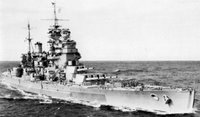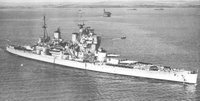Sunday Battleship Blogging: HMS Duke of York
 HMS Duke of York was the third of the King George V class, the first “Treaty” battleships designed and built for the Royal Navy. Like other Treaty battleships, Duke of York was limited to a 35000 ton displacement. The United Kingdom had hoped that gun size would be restricted to 14″, and designed Duke of York around 14″ guns instead of around a previously decided 15″ arrangement.
HMS Duke of York was the third of the King George V class, the first “Treaty” battleships designed and built for the Royal Navy. Like other Treaty battleships, Duke of York was limited to a 35000 ton displacement. The United Kingdom had hoped that gun size would be restricted to 14″, and designed Duke of York around 14″ guns instead of around a previously decided 15″ arrangement.
The design had a number of problems. Because the Royal Navy expected to be able to rely upon many refueling bases, Duke of York’s range was very short. This meant that, during the Bismarck pursuit, Prince of Wales had to break off due to lack of fuel, and King George V was nearly forced to do the same. The decision to mount 14″ guns was a disaster. They could not be mounted in the planned three quadruple turret arrangement, so Duke of York only carried 10 guns. The 14″ guns had notably less “oomph” than the naval weapons carried by other navies; although Prince of Wales scored one penetrating hit on Bismarck at Denmark Straits, King George V’s shells bounced off Bismarck’s belt armor a week later. The quadruple turrets also had serious malfunction problems. On the upside, Duke of York and her sisters were heavily armored (although the armor wasn’t as well-arranged as it could have been), and could make a higher speed than their American or Japanese counterparts (with the exception of the US Iowa class).
Duke of York was, nonetheless, a powerful ship. She displaced 37000 tons, carried 10 14″ guns, and could make 29 knots. The differences between fast battleships are a bit over-stated, as situational factors and luck would probably have determined the outcome of combat between any but the most seriously mismatched of opponents. The day after Christmas 1943, just such battle took place. The German battlecruiser Scharnhorst received word of an Allied convoy, and put to sea on Christmas Day. Scharnhorst knew that British cruisers were about, but had no idea that the Duke of York was also escorting the convoy. Scharnhorst skirmished with several British cruisers before breaking off and turning for Norway. Blinded by damage to her radar, she didn’t detect Duke of York until the latter opened fire at a range of about 12000 yards. Scharnhorst turned to flee (she could outrun Duke of York), but a lucky shot hit a boiler, reducing Scharnhort’s speed to 20 knots. This made the result of the engagement a foregone conclusion; Duke of York continued to hit Scharnhorst, and British destroyers eventually moved in for the killing blow with torpedos.
 Following the destruction of Tirpitz, last major German raiding threat, Duke of York was transferred to the Pacific, where she took part in the invasion of Okinawa. After the war Duke of York served as flagship of the Home Fleet for several years before being decommissioned in 1949. The Royal Navy fell victim to a general post-war belt-tightening in the UK, and Duke of York was sold for scrap in 1957.
Following the destruction of Tirpitz, last major German raiding threat, Duke of York was transferred to the Pacific, where she took part in the invasion of Okinawa. After the war Duke of York served as flagship of the Home Fleet for several years before being decommissioned in 1949. The Royal Navy fell victim to a general post-war belt-tightening in the UK, and Duke of York was sold for scrap in 1957.
UPDATE: As Alex has noted, “Barehands” Bates, who repaired Duke of York’s radar at a critical moment during the Battle of North Cape, passed in early May of this year.
(Images courtesy of Maritimequest.)
Trivia: The Washington Naval Treaty mandated the destruction of most pre-dreadnought battleships. Name the fourfive US pre-dreadnoughts that survived the naval treaties.


